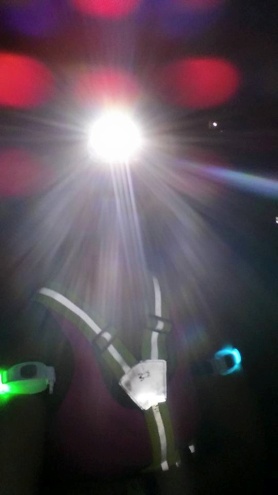
It was just before 9 p.m. on a warm June evening as I headed out for my nightly run. I waited to cross at an intersection. When I got the walk signal, I looked both ways and stepped into the crosswalk. I made it about one-quarter of the way across the street when a motorist who was making a left-hand turn came within inches of running me down.
“Could you not see me?” I shouted.
“No,” the driver shouted back. “It’s dark and you’re in the street.”
I did everything I was supposed to do. When I run at night, I wear a reflective vest with a blinking light on the back, more blinking lights on my arms and legs, and a headlamp. I look like something out of Tron. But to the driver I was invisible, not because I wasn’t wearing enough lights, but because in her mind I just didn’t belong there.
There’s no single entity who is responsible for making sure our streets are safe for everyone, so it’s hard to know where the greatest battle lies. Is it with the planners and engineers who design our roads? Is it with the elected officials who make and pass laws? Or with the police, who are supposed to enforce those laws? According to Peter Norton, a historian at the University of Virginia Center for Transportation Studies and the author of Fighting Traffic: The Dawn of the Motor Age in the American City, the real battle is for people’s minds:
“[Th]e battle isn’t to change rules or put in signs or paint things on the pavement… The real battle is for people’s minds, and this mental model of what a street is for. There’s a wonderful slogan used by some bicyclists that says, ‘We are traffic.’ It reveals the fact that at some point, we decided that somebody on a bike or on foot is not traffic, but an obstruction to traffic. And if you look around, you’ll see a hundred other ways in which that message gets across. That’s the main obstacle for people who imagine alternatives—and it’s very much something in the mind.”
A century ago, when drivers got behind the wheel they saw it as their responsibility to watch out for others in the street. But that all changed as car ownership increased, and more and more people “saw themselves as more likely to be behind a wheel than under one.” In the five years between 2007-2011, 60 percent of Bay Area drivers who were found to be at fault for killing pedestrians or suspected of a crime like a hit and run did not face criminal charges. Why? Because “juries too often sympathize with the driver” and “don’t want to call this person a criminal.”
This backslide in thinking continues today, even in New York City, where the majority of households are car-free. Two bills being considered in the New York City Council would weaken the Right of Way law, which increases penalties for drivers who fail to exercise due care and injure a person with the right of way, such as a pedestrian — like me — crossing with a walk signal. I’m hopeful that New York City’s leaders will recognize that pedestrians need more — not fewer — protections, and that this attempt to water down the Right of Way law turns out to be nothing more than a close call — like mine was.

[…] NYC Needs to Strengthen Protections for Pedestrians, Not Water Them Down (MTR) […]
Good post. Thanks!
There are two (2) different conversation that need to take place. The first is that pedestrians and bicyclist have the same rights to use the public right of way as motorists. The second conversation is that pedestrian and bicyclist amenities must be provided in a safe manner. This second conversation continues to be overlooked. There is no doubt that our roadways have been designed for the use of motorists and the amenities that are part of roadway design are vehicular in nature. So why would we assume these same amenities will keep pedestrians and bicyclist safe as well? The 1/8th inch high white line that constitutes a bike lane (if provided at all) continues to prove to be deficient in stopping or redirecting vehicles from entering bike lanes and striking bicyclists. Despite what our legislators or complete streets advocates tell us, a pedestrian’s or bicyclist’s safety is not dependent on legislation or adapted vehicular amenities. Rather it is dependent on the provision of amenities that are designed for pedestrian and bicyclist safety.
Let’s not put a price on bike/ped heads to ultimately fund a safe amenity in the public right of way. By the time we raise enough money, we may not have any users left!
FHWA’s Separated Bike Lane Planning and Design Guide is a good start to the second conversation. http://www.fhwa.dot.gov/environment/bicycle_pedestrian/publications/separated_bikelane_pdg/separatedbikelane_pdg.pdf
Jana – Thanks for the article. Pedestrian safety is an important item. The picture is instructive, though. There’s nothing in that picture that looks like a person. No wonder the driver didn’t see you. Without a frame of reference for the lights you were sporting to provide some depth perception, the lights could just have easily been on a building across the street – or elsewhere.